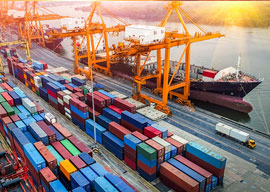Official figures released by Exim’s expert panel through Brazil import and export data on Monday indicated that Brazil had a record $61 billion trade surplus in 2021, and the Economy Ministry anticipates that amount to rise to $79.4 billion this year owing to lower imports.
Last year, exports in Latin America's largest economy hit a new high of $280.4 billion, owing mostly to price increases caused by the COVID-19 outbreak, while imports totaled $219.4 billion.
Exports, primarily to the United States, increased by 44.9 percent. Sales to China, Brazil's largest commercial partner, increased by 28%. Imports from the Mercosur trade group grew at the fastest rate of 44.7 percent in 2021, followed by the United States (41.3 percent) and China (36.7 percent)
Brazil Export Statistics suggest that Brazil exports are predicted to climb by 1.4 percent to $284.3 billion in 2022, while imports are expected to shrink by 6.6 percent to $204.9 billion, according to the ministry. Global commerce is expected to rise at a more modest pace this year, according to forecasts.
In January 2022, based on Brazil export statistics, Brazil exported $19.6 billion and imported $19.8 billion, resulting in a $214 million trade deficit. Brazil's exports climbed by $4.69 billion (31.4 percent) from $14.9 billion to $19.6 billion between January 2021 and January 2022, while imports rose by $4.68 billion (30.9 percent) from $15.2 billion to $19.8 billion.
Brazil Trade Statistics 2022
According to Brazil customs import data, Imports to Brazil increased by 24.6 percent to $19.85 billion in January 2022, driven by increases in sales of manufactured goods (+14.9%) and mining goods (+325.8%), while agricultural imports fell by 15.7 percent.
Stats Related | Total Value | Unit | Reference Year |
Total Imports of Brazil | $19849.00 | USD Million | January 2022 |
Total Exports of Brazil | $19673.00 | USD Million | January 2022 |
Trade Balance | $-200.00 | USD Million | January 2022 |
Current Account | $-8146 | USD Million | January 2022 |
Brazil’s Top Import Partner Countries 2022
The United States, Germany, China, India, European Union, South Korea, Argentina, Russia, Chile, and Japan are the top import partner countries of Brazil according to Brazil Import Data 2022.
Country | Total Value Last | Total Value Previous | Unit | Year Reference |
United States | $4076.80 | $4359.20 | USD Million | January 2022 |
Germany | $858.96 | $885.60 | USD Million | January 2022 |
China | $5113.55 | $4788.55 | USD Million | January 2022 |
India | $567.06 | $496.43 | USD Million | January 2022 |
European Union | $2938.61 | $3001.86 | USD Million | January 2022 |
South Korea | $472.00 | $418.00 | USD Million | January 2022 |
Argentina | $795.86 | $1234.75 | USD Million | January 2022 |
Russia | $529.98 | $415.63 | USD Million | January 2022 |
Chille | $357.98 | $316.77 | USD Million | January 2022 |
Japan | $388.58 | $374.47 | USD Million | January 2022 |
You can buy Brazil import-export trade data through Exim Trade Data and get access to the latest updates and insights into Brazil import and export trade data and activities. Brazil import-export trade data help you find potential buyers and suppliers for your trade in Brazil.
The customs trade data Exim provides helps you locate new marketplaces in the overseas market for your global import-export trade business. Exim’s customs reports allow you to track and monitor the market competitions as well as the strategies your business rival uses for their import-export trade business.









